Bulletin – March 2019 Finance Developments in Banks' Funding Costs and Lending Rates
- Download 535KB

Abstract
Banks' funding costs increased a little over 2018, driven by a rise in the cost of wholesale funding linked to money market rates, but with some offset from reductions in the cost of retail deposits. Most lenders passed the increase in funding costs through to their lending rates, including for mortgages. Nevertheless, funding costs and lending rates remain low by historical standards.
Funding costs typically influence lending rates
The rates that banks offer on loans to households and businesses are partly driven by the cost of their funding. Banks also take into account the risks inherent in lending, such as the credit risk associated with loans and the liquidity risk involved in funding long-term assets with short-term liabilities. Competition in the financial sector, banks' growth strategies and the rate of return desired by equity holders also affect their lending rates.
The level of the cash rate is an important determinant of banks' funding costs (Graph 1). This is because the cash rate acts as an anchor for the broader interest rate structure of the domestic financial system. The pass-through from the cash rate to funding costs and lending rates is an important channel of monetary policy transmission (Brassil, Cheshire and Muscatello 2018). Nevertheless, there are other factors that influence funding costs, such as changes in the level of compensation required by investors for holding bank debt. The full effect of such changes can take some time to flow through to funding costs and lending rates. This article updates previous Reserve Bank research, focusing on developments in major banks' funding costs and lending rates over 2018 (McKinnon 2018).
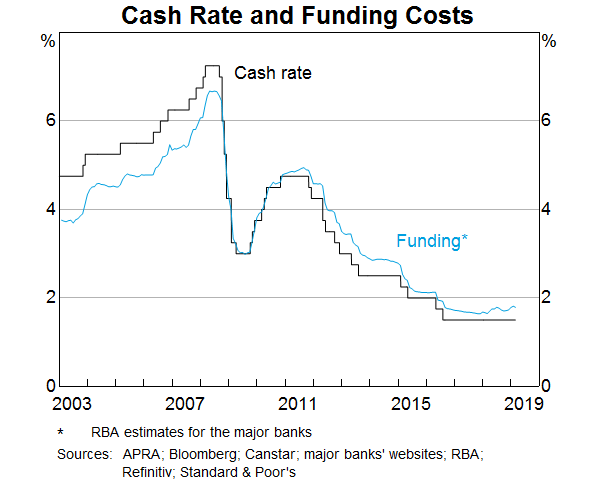
The cost of banks' funding increased a little over 2018, driven by the higher cost of raising funds in wholesale debt markets as a result of increases in money market rates, in particular the rise in bank bill swap (BBSW) rates. The costs of around two-thirds of the major banks' debt and deposit funding are ultimately linked to BBSW rates, either directly or as a result of their interest rate hedging practices. The major banks' overall funding costs have increased by less than money market rates because of the decline in interest rates on retail deposits, which account for around one-third of their non-equity funding.
Most lenders, including the major banks, have passed the increase in funding costs through to their lending rates. However, the average interest rate on outstanding housing loans increased only a little toward the end of 2018, and by less than the increases in banks' standard variable rates (SVRs) for housing loans. This owed in large part to strong competition for low-risk borrowers, as observed through the larger discounts that banks offered from their SVRs. Rates on loans to businesses also increased, particularly for large business loans, since many of these loans are linked to BBSW rates. Despite the increases, both funding costs and lending rates remain historically low, consistent with the low level of the cash rate.
Banks' funding composition was little changed over 2018
Banks obtain funding from four main sources: retail deposits, wholesale deposits, wholesale debt and equity. Excluding equity, around one-third of major banks' funding is from retail deposits. These are sourced from households and small- to medium-sized businesses. Another third of non-equity funding is from wholesale deposits, such as those from large corporations, pension funds and the government. Short- and long-term wholesale debt account for most of the remaining third of funding. The composition of major banks' funding was little changed over 2018 (Graph 2).
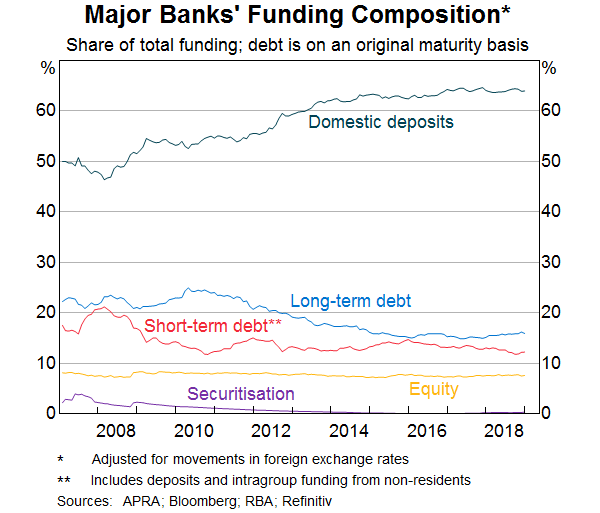
In aggregate, deposits account for around two-thirds of major banks' non-equity funding. This share has been relatively stable over recent years, following a large increase in the share of deposits in the aftermath of the global financial crisis. That increase was consistent with banks seeking more stable funding, particularly from term deposits (Graph 3). The introduction of new liquidity regulations – such as the Net Stable Funding Ratio requirement that came into force at the start of 2018 – has also supported the banks' demand for stable funding over recent years. Deposit growth slowed in 2018, in line with the generally subdued growth in banks' assets.
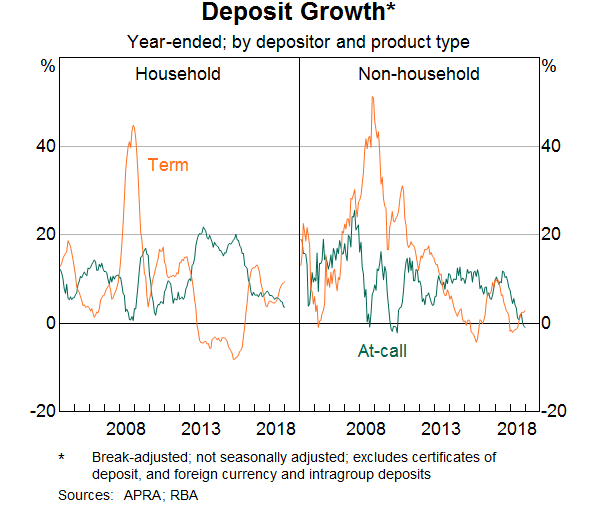
The share of funding sourced by the major banks from wholesale debt markets was little changed over 2018. Within this, the major banks shifted their funding slightly, moving away from short-term debt toward long-term debt (Graph 4). A large share of wholesale debt funding for the major banks is sourced from offshore markets, mainly in US dollars. Australian banks transform most of these foreign-currency denominated exposures into Australian-dollar denominated exposures using the cross-currency swap market. As a result, Australian banks are far less sensitive to changes in interest rates in other jurisdictions than their share of offshore funding may suggest (Kent 2018).
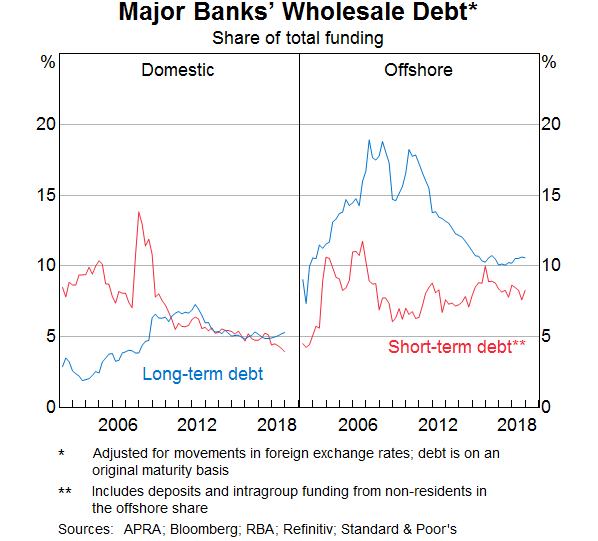
The share of funding from equity has been stable
In addition to deposits and debt, banks obtain a small portion of their funding from equity. The share of funding from equity has been stable over recent years. Since mid 2015, banks have increased their stock of equity funding by around $40 billion. This was largely in response to changes in prudential regulations that have increased the average mortgage risk weights, and therefore the amount of capital that banks are required to hold. The major banks continue to indicate that they are on track to meet the Australian Prudential Regulation Authority's (APRA) increased ‘unquestionably strong’ capital benchmarks by 2020 (as expected by APRA). Distinct from its ‘unquestionably strong’ benchmarks, APRA consulted on plans in late 2018 to implement a loss-absorbing capacity regime in Australia from 2023 (APRA 2018).
Banks' funding costs are a little higher than in recent years but remain low
We estimate that overall debt and deposit funding costs for the major banks increased by around 10 basis points over 2018 (Graph 5). This was driven by increases in the costs of wholesale debt and wholesale deposits. Nevertheless, funding costs remain low by historical standards.
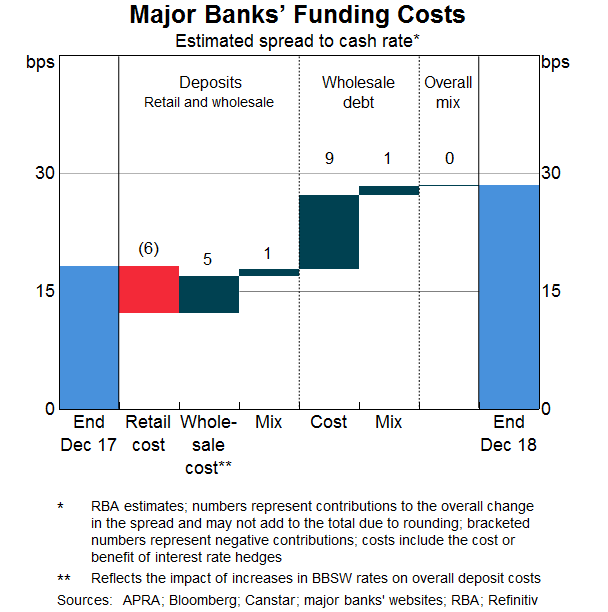
The cost of wholesale funding increased …
Wholesale funding – which includes both wholesale debt and wholesale deposits – accounts for around two-thirds of major banks' non-equity funding. Wholesale funding costs tend to be roughly linked to BBSW rates, which increased in 2018 (Graph 6).
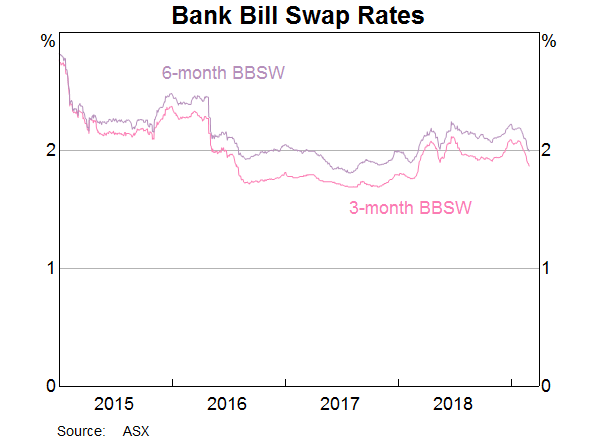
BBSW rates measure the cost for highly rated banks in Australia to issue short-term bank paper with tenors of up to six months. These rates are some of the key interest rate benchmarks for the Australian dollar and are widely used as reference rates in contracts including derivatives, loans and securities (Alim and Connolly 2018). BBSW rates are heavily influenced by expectations for the cash rate, although they are also affected by other factors, including developments in offshore money markets and changes in the demand for short-term bank paper from investors.[1]
The cost of wholesale debt for Australian banks is ultimately linked to BBSW rates either directly or as a result of their interest rate hedging practices. In addition to issuing floating-rate Australian-dollar denominated debt (at a spread to BBSW rates), banks swap much of their foreign-currency denominated or fixed-rate debt into Australian-dollar floating-rate exposures by using derivatives that typically use a BBSW rate as the reference rate (for more, see Cole and Ji 2018). These hedging practices better align movements in the rates on Australian banks' funding with those that they receive on their assets, which consist largely of loans that are variable rate and denominated in Australian dollars. Rates on wholesale deposits also tend to be closely linked to BBSW rates. In particular, wholesale term deposits are close substitutes for bank paper of the same tenor, so the rates offered on these deposits tend to move with BBSW rates.
Wholesale funding costs moved broadly in line with BBSW rates over 2018, with BBSW rates around 20 basis points higher than their average in 2017 (Graph 6). In particular, BBSW rates rose noticeably toward the end of the March, June and December quarters, as did other short-term money market rates in Australia and offshore. Most of the impact of a change in BBSW rates flows through to wholesale funding costs in three to six months, with the time frame varying between banks based on the maturity profiles of their short-term debt, wholesale deposits and interest rate hedging instruments. The increases in BBSW rates were reflected in higher costs for outstanding short-term and, to a lesser extent, long-term wholesale debt. Nevertheless, wholesale funding costs remain low relative to recent history (Graph 7).
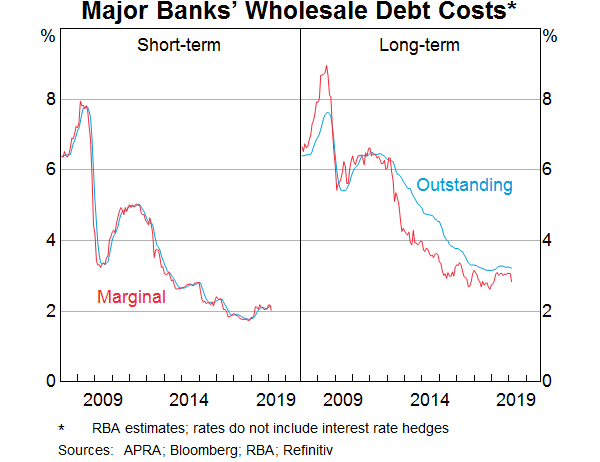
A few factors other than BBSW rates also put upward pressure on the cost of wholesale debt in 2018, although their contributions were relatively small. The major banks' wholesale debt that is issued offshore was affected by increases in cross-currency basis swap spreads, which measure the cost of swapping foreign-currency exposures into Australian-dollar exposures. In particular, the major banks' cost of sourcing short-term debt funding in US dollars and swapping it into Australian dollars increased by a little more than the increases in BBSW rates (Graph 8). Nevertheless, Australian banks may still prefer to issue offshore – even when it appears to be relatively more expensive – to diversify their funding base (Kent 2018). The slight shift in the composition of wholesale debt from short term to long term added a little to funding costs, along with an increase in the average original tenor of the major banks' long-term debt.
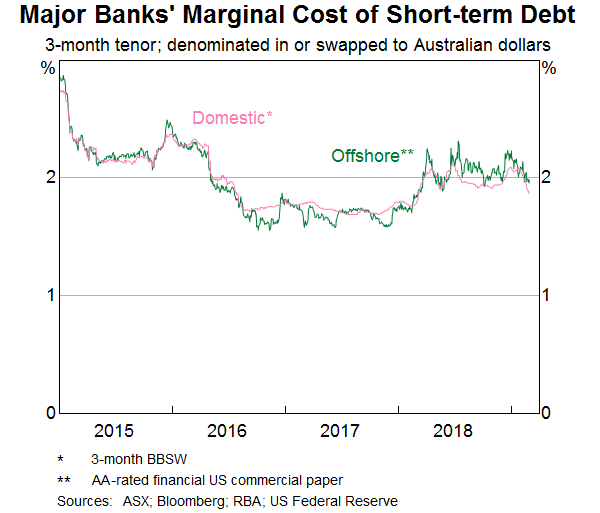
Banks continued to issue wholesale debt at relatively low yields in 2018. Australian banks issued bonds at a similar pace to previous years, with around $115 billion of bonds issued in the year. Net issuance, which takes into account bond maturities, was high in 2018, with issuance outpacing scheduled maturities by around $25 billion. Although spreads to benchmark rates for the major banks' bonds widened over 2018, yields remained little changed around the low levels of recent years (Graph 9).
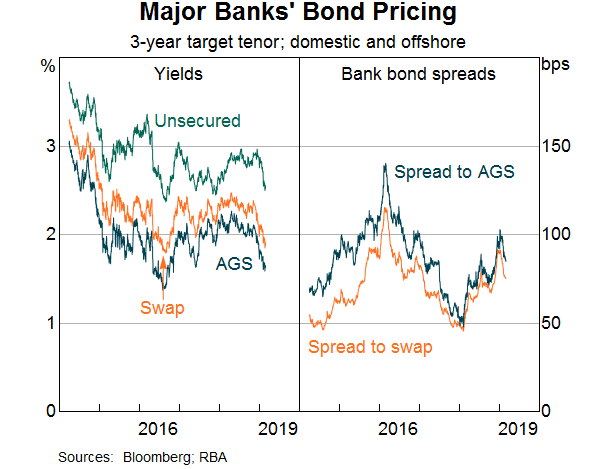
… but this was partly offset by a decrease in the cost of retail deposits
Major banks' funding costs increased by less than money market rates because the cost of retail deposits declined. Major banks' overall deposit costs therefore fell over 2018, even though wholesale deposit rates increased (Graph 5). The decline in the cost of retail deposits was in large part due to substantial reductions in all of the major banks' base rates on online savings accounts (excluding any ‘honeymoon’ or introductory bonus rates) (Graph 10). Honeymoon rates on online savings accounts were little changed. Partly offsetting this, there was a small increase in the major banks' average rate on bonus savings accounts. Major banks' advertised rates on retail at-call deposits remain low relative both to historical rates and to rates currently offered by non-major banks.
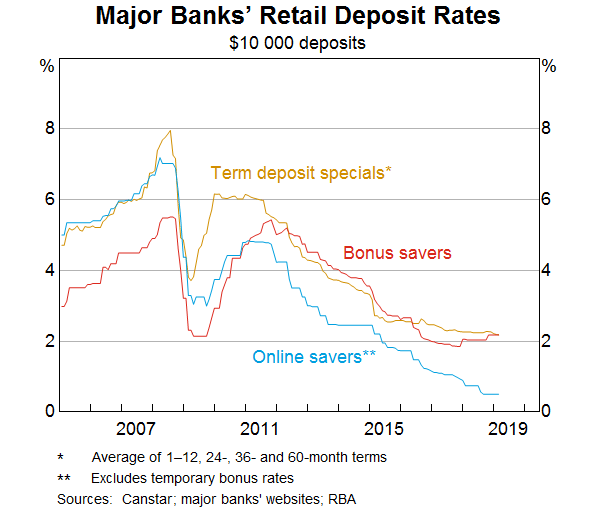
Although rates on new retail term deposits were little changed over 2018, the cost of outstanding term deposits fell slightly because some term deposits that were contracted at higher rates in earlier years have since been replaced by term deposits at lower rates. However, the impact of this on overall funding costs was somewhat offset by a change in the mix of deposits toward term deposits, which typically have higher interest rates than at-call deposits.
Banks increased their lending rates a little, but they remain low
Most lenders passed the increase in funding costs through to their lending rates for households and businesses. But lending rates remain low, consistent with funding costs and the cash rate.
Interest rates on housing loans rose a little for many borrowers over 2018. Most banks increased their SVRs on housing loans in the second half of 2018 by around 10–15 basis points. The banks generally attributed the increases to higher funding costs. However, the average interest rate on outstanding variable rate housing loans increased by only a few basis points over the second half of the year (Graph 11). This was partly because not all lenders raised their SVRs in that period; one of the major banks increased its housing SVRs in early 2019. In addition, interest rates on new housing loans continued to be significantly lower than interest rates on outstanding loans, which provides an indication of the strength of competition for low-risk borrowers. Some existing borrowers refinanced at a lower rate with a different lender or renegotiated the rate of their loan with their existing lender. Moreover, advertised interest rates on fixed-rate housing loans, which account for around one-fifth of outstanding housing credit, declined throughout 2018.
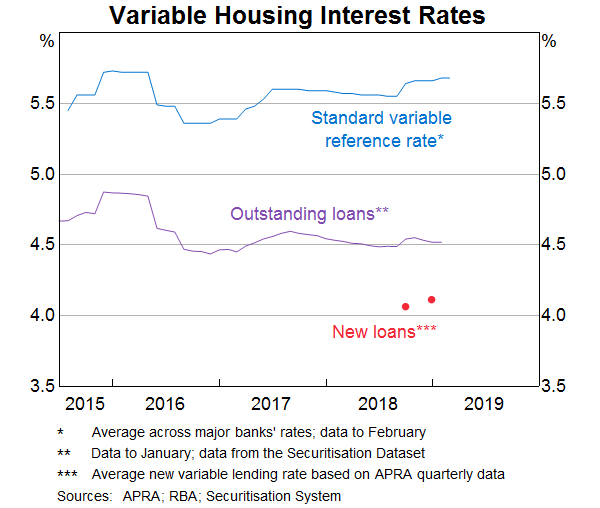
Interest rates on outstanding loans to large businesses are estimated to have increased by around 35 basis points over 2018, reflecting in part the increases in BBSW rates (Graph 12). Most loans to large businesses are linked to BBSW rates. Rates on loans to small businesses were little changed over the year, though they remain noticeably higher than those for large businesses. Some banks increased their advertised rates for small businesses toward the end of 2018, citing higher funding costs.
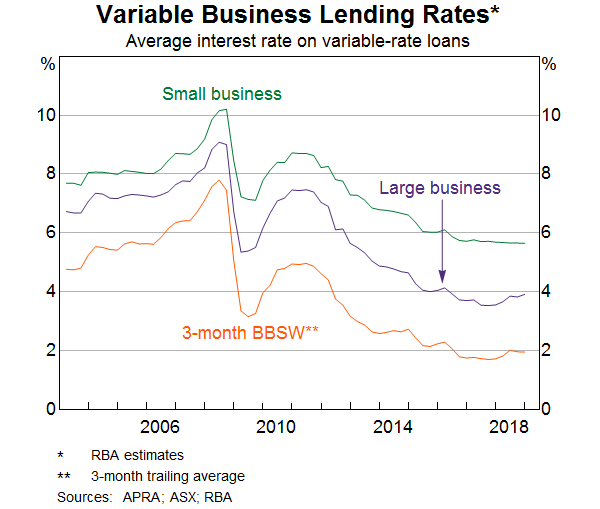
Banks' implied lending spread narrowed a little
A bank's implied spread on its outstanding lending is the difference between its average lending rates and overall funding costs. We estimate that this spread narrowed slightly for the major banks over 2018 (Graph 13). The implied lending spread did not narrow by as much as the increase in funding costs because much of this increase was passed through to an increase in lending rates, including for mortgages and large business loans.
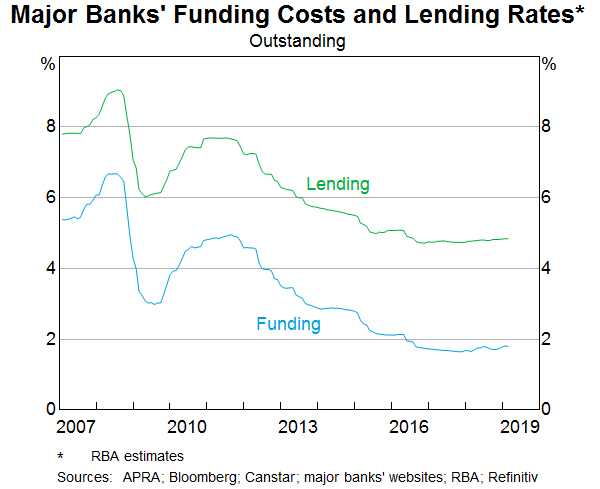
The implied lending spread differs from some commonly reported measures of bank profitability (for example, the net interest margin), because it excludes the returns on banks' other interest-earning assets, such as high-quality liquid asset holdings. Yields on some of the banks' liquid assets rose over 2018, consistent with increases in BBSW rates. The effect of this was to dampen the impact of higher funding costs on banks' net interest margins.
Footnotes
The authors are from Domestic Markets Department. [*]
For information on factors that influenced BBSW rates in 2018, please see RBA (2018). [1]
References
Alim S and E Connolly (2018), ‘Interest Rate Benchmarks for the Australian Dollar’, RBA Bulletin, September.
APRA (Australian Prudential Regulation Authority) (2018), ‘Increasing the loss-absorbing capacity of ADIs to support orderly resolution’, APRA Discussion Paper, 8 November. Available at <https://www.apra.gov.au/sites/default/files/increasing_the_loss-absorbing_capacity_of_adis_to_support_orderly_resolution.pdf>.
Brassil A, J Cheshire and J Muscatello (2018), ‘The Transmission of Monetary Policy through Banks' Balance Sheets’, in Central Bank Frameworks: Evolution or Revolution?, Proceedings of a Conference, Reserve Bank of Australia, Sydney, pp 73–122.
Cole D and D Ji (2018), ‘The Australian OTC Derivatives Market: Insights from New Trade Repository Data’, RBA Bulletin, June.
Kent C (2018), ‘US Monetary Policy and Australian Financial Conditions’, Speech at Bloomberg, Sydney, 10 December.
McKinnon T (2018), ‘Developments in Banks' Funding Costs and Lending Rates’, RBA Bulletin, March.
RBA (Reserve Bank of Australia) (2018), ‘Domestic Financial Conditions’, RBA Statement on Monetary Policy, August, pp 39–50.